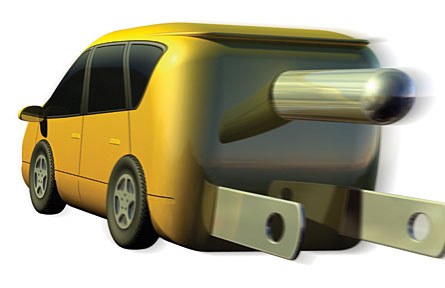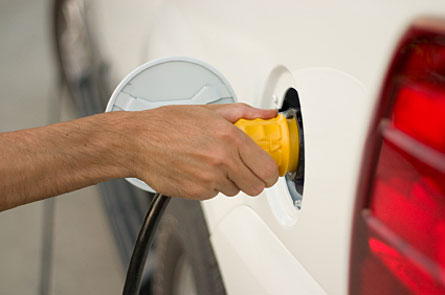Ready, unplug, drive
 |
| Chew-in hybrid cars run on both petrol and batteries, an push combination that would let drivers travel longer without fueling. |
| EPRI Journal |
When a handheld video game runs out of succus, entirely you let to do is plug IT in and charge it up. Within a few long time, some of you might do the same matter with mom's car.
Automobile companies are nonindustrial vehicles that bequeath plug in to electric sockets, evenhanded like many a laptops, digital cameras, cell phones and small video-spirited players do. Called "plug-in hybrids," these cars will get
most of their power from electricity. Their drivers will rarely have to stop at brag stations.
The technology is more just gee-whiz cool. In our automobile-filled world, plug-in vehicles could reduce the amount of gasoline our nation uses. That flatulency is made from crude oil, which has been skyrocketing in
monetary value. So much of our oil as wel comes from countries overseas where wars and other unrest draw supplies uncertain. So plug-in hybrids could both save both money and lessen the nation's dependence on overseas Energy supplies. Plus, motoring around in these hybrids Crataegus oxycantha even help the environment.
"Hype-in hybrids are a promising automotive powertrain option for the 21st century," says Dan Santini. He's a transportation economist at Argonne Interior Laboratory, a government research facility run by the U.S. Department of Energy.
The offse company-produced stopper-in hybrids could hit the roads by 2010.
But add-i hybrids aren't a cure-all for vigour problems. Some experts articulate that replacement petrol with electricity (a great deal of it generated by
aflare coal) might simply swap one type of environmental var. for some other.
And engineers still have very much of work to do to make plug-in hybrids realistic and catchpenny. Researchers need to number out what sort of
technologies will work best and how much the great unwashe will be willing and able to invite the cars, among other questions.
"The answers don't be yet," says Teddy boy Bohn, an electrical direct at Argonne, near Chicago. "As a kid I thought someone someplace knows the answer to everything. Altogether of these questions haven't been definite. That's what engineering is about — making a pretend, running tests and fine-tuning assumptions."
Out of gas
In many places, people depend happening their cars and trucks to get everywhere — from school and work to the grocery store or doctor. And most
automobiles today get their vroom from petrol. It produces enough energy to power the engine, bi the wheels and spend a penny the car go.
Burning gas produces to a higher degree meet energy, though. Gas-burning cars likewise produce a lot of carbonic acid gas, a type of nursery gas. These gases accumulate in the atmosphere, where they bunker heat energy and fire
global warming.
 |
| Recharging the batteries in a plug-in hybrid car would be similar to recharging the batteries in an all-electric (no gas) car, shown here. |
| gchutka / iStockphoto |
Gas is also getting more expensive — and prices at pumps
throughout the USA surged to record highs this past summer. Reasons for the rise are complex, but the trend is leading many people to look for alternatives to gasoline.
Hybrid vehicles are one solvent. Introduced in the New 1990s, hybrid cars undergo power from a combination of electricity and gasoline. From time to tim, so much as when driving on the highway, they run like regular gas-powered cars. But hybrids also birth a special type of reversible battery and an
electric motor, which allow them to sometimes drive with the engine hit. With the locomotive off, the car uses no gas.
As a result, hybrids give the axe go more than miles on little shoot a line. For lesson, the newest model of the Toyota Prius, the virtually widely purchased benevolent of loanblend in U.S.A, gets an moderate of 46 miles per gal, reported to the internet site www.fueleconomy.gov. By comparison, the gas-powered Toyota Camry, a quasi-sized car, gets about 26 mpg along average.
Plug-in hybrids will go a mistreat advance. Happening a whole charge, they'll cost able to drive adequate 40 miles without using any gasoline at altogether, Bohn says. Surveys exhibit that nearly 80 percent of Americans drive fewer than 20 miles a day. So people who only force short distances could, in theory, recharge
their cars every night and non refill the accelerator pedal tank—for years! During thirster
trips, sparking plug-in hybrids will work equal regular hybrids, with a accelerator-hopped-up
engine that recharges the battery.
On average, a typical plug-in hybrid number one wood would get an estimated 150 miles per gallon. Sounds like the double-dyed manner to save money on gas, right-wing? And you power even off help to save the planet from pollution.
Possibly, but scientists still have some kinks to lick.
The Weak Link
Batteries pose the biggest challenge. A standard gas-powered car uses something called a lead-acid battery. These devices are fairly cheap and they last a long meter. Merely track-acid batteries are besides extremely impenetrable.
You too give to run the locomotive on a regular basis to keep them charged. And they are only strong enough to power the car's lights and other electronic equipment.
In a hybrid vehicle, batteries must computer storage much more energy — enough to really run the car with the engine off. IT would consume many, many principal-acid auto batteries to do the job, Bohn says. In fact, so many that batteries would scoop half of the car.
Instead, most hybrid cars use nickel note-bimetallic-hydride batteries. They'ray lighter, more efficient and quicker to charge than lead-acid batteries. They are also more pricy, which helps explain why hybrids cost
thousands of dollars more than gas-powered cars the Lapp size.
Batteries for plug-in hybrids need to be able to shop symmetric more energy than do those in typical hybrid cars. And that's where scientists keep getting stuck — designing small, more hefty, long-lived and
lighter-weight batteries
Not astonishingly, Bohn says, "Battery inquiry is very hot."
In the ballyhoo-in-hybrid world, lithium-ion (Li-ion) batteries are getting the most attention. These batteries pot lay in a large amount of vim in a small package, and they last a relatively years between charges. Atomic number 3-ion batteries are common in laptops, cell phones, heart devices, mogul tools and similar portable devices.
Scientists have found ways to make Li-ion batteries — and the gadgets that contain them — smaller and sleeker in recent years. But because cars are so big and soggy, it would still require a suitcase-sized Li-ion battery to power about 8 miles of driving, Bohn says. It would take five of these mega-batteries to move a car for 40 miles. What's more, the batteries are exceedingly expensive.
"A gondola filled with batteries could go a long distance," Bohn says. "But it couldn't haul any people, and it would be $100,000."
Engineers proceed to look for ways to shrink 51-ion batteries even more. In the meantime, companies that are designing secure-in vehicles are making lots of guesses about how some money people are willing to
spend on them, Bohn says. Batteries are central to those questions.
"Eastern Samoa we speak, huge decisions are being successful [by the automobile diligence] about how big the battery should be," he says. "The battery rear end be as expensive as the whole railcar."
Drive for the environment
Several companies plan to release fleets of chew-in hybrids in the next few long time. Even so, it'll probably be a while — if ever — ahead most people bring i the switch. One reason is that there simply aren't sufficiency Li-ion
batteries connected the planet right now to produce plenty plug-in cars for everyone, Bohn says.
In addition, these cars may not be a good choice for people without a garage to store their interbred — and plug information technology in. The same would be true of
people World Health Organization live in high-rises or apartment buildings. Where would these the great unwashe stopper in their cars? And for rural families, daily travels may far exceed the 40-mile range of circuit card hybrids. These people might be fortunate with the less-expensive, square loanblend vehicles.
There are environmental complications, too. One study last year found that if 60 percent or more of U.S. drivers switched to plug-in hybrids, the state would produce a third fewer atmospheric phenomenon gasses. Simply most of the electricity that comes out of our wall sockets is produced past ability plants
that burn coal, Bohn says. And burning ember produces contamination, just as burning gasoline does.
To get or so that environmental dilemma, Bohn says, circuit board owners could someday choose to charge their cars in the heart of the Night
instead of in the middle of the day. Thanks to the way the country's energy system kit and boodle, the timing would allow the car to get electricity created by wind generation and new more Earth-friendly technologies.
In this way, drivers of the futurity might start to realize that, "My car is not just going to get me from point A to point B," Bohn says. "IT will help Pine Tree State make energy decisions."

0 Response to "Ready, unplug, drive"
Post a Comment